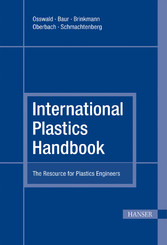Tim A. Osswald, Erwin Baur, Sigrid Brinkmann
International Plastics Handbook
PREFACE
As the title suggests, this handbookwaswritten as a source of reliable information for the practicing engineer, in a world which is increasingly driven by globalization. While it was written for the American market, the book also includes international standards and information that is now often necessary for any practicing engineer. Plastics remains the material group with the largest growth rate worldwide. This is due to their unique characteristics; the ease of production of complex parts with relatively economical processes, and the ability to tailor the properties of the material to suit a specific application. Due to these attributes, today we find that plastics are not only replacing traditionalmaterials, but are the driving force in innovation in the fields of electronic products,medicine, automobiles, household goods, and construction. Thus, we find uncountable examples of how plastics have improved our standard of living in the last decade alone; from lighter automobiles to thinner cellular telephones, and from more fuel ef- ficient composite aircraft to improved human heart valves, all made possible by advances in plastics and plastics technology. The plastics industry will continue to grow and develop, as the properties of polymers achieve higher limits, continuously replacing other materials and making new applications and products possible. The image of plastics has seen a positive turn in the last decade. Many studies have shown that plastics are the driving force in the solution of ecological problems; from making vehiclesmore fuel efficient, to allowing themanufacture of complex products with a fraction of the energy required when using metals. Furthermore, today we find ourselves revisiting the past, where plastics were made of renewable resources.
At the end, it is really only a question of economics, whether we will make plastics from petroleum or from bio-materials. From this point of view, we can really say that the age of plastics is still in its infancy. International Plastics Handbook is based on a similar publication, which has been available to the German plastics engineer for the past 70 years. A new edition of the German book Saechtling Kunststoff Taschenbuch, now in its 29th edition, appears every three years at the K-Show, in Duesseldorf, Germany. In 1936, when the first edition of the German book was published, Dr. F. Pabst, the original author of the German handbook, wrote "This book is intended to answer questions in the applied field of plastics." For this handbook, that is our intent as well. This first edition of International Plastics Handbook will appear at the NPE show in Chicago, in June of 2006. Due to the rapid changes in the field of plastics we are planning to present new editions of the handbook at NPE shows, every three years. In addition, this book will be accessible through the World- WideWeb where the authors will maintain updated versions of the handbook, including its tables and list of trade names.
Each handbook contains an individual code on the inside front cover which provides access for the download of the electronic version of the book at www.hanser.de/plasticshandbook. The authors cannot possibly acknowledge everyone who in oneway or another helped in the preparation of this handbook. First of all wewould like to thank Drs. Wolfgang Glenz and Christine Strohm of Hanser publishers for being the catalysts for this project. Additionally, Dr. Strohm gave us her input and support during the years it took to prepare this handbook. Chapter 6 comes from the German Saechtling Kunststoff Taschenbuch materials chapter, which was translated by Dr. Strohm. We are indebted to her for all of this. Special thanks are due to Luz Mayed D. Nouguez for the superb job of drawing the figures. We are grateful to Sylvana Garc´ýa and Alejandro Rold´an for the long hours they put into generating tables for the book and preparing the camera-ready manuscript. We thank Juan Pablo Hern´andez-Ortiz for developing the typesetting template. We also thank Oswald Immel for his support throughout the development of the manuscript. Above all, we thank our families for their patience, encouragement and support.
TIM A. OSSWALD Madison, Wisconsin Spring, 2006
© 2009-2024 ciando GmbH
 Zu Hanser-Fachbuch.de
Zu Hanser-Fachbuch.de
 Warenkorb
Warenkorb
